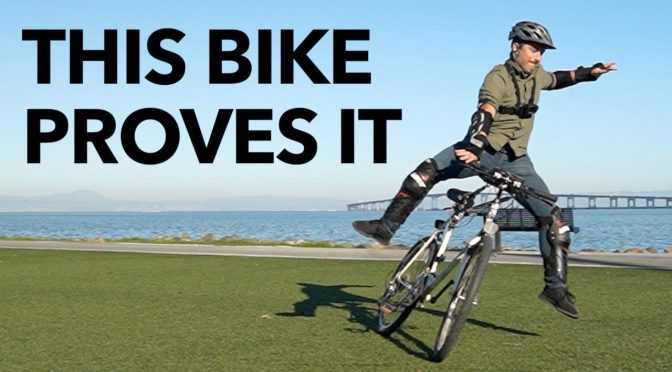In the video titled “Most People Don’t Know How Bicycles Work” by Veritasium, the seemingly simple act of riding a bicycle is dissected to reveal the complex physics that underpin it. The video challenges common misconceptions about bicycle stability and steering, and provides a comprehensive explanation of the mechanisms that allow a bicycle to stay upright and navigate turns.
Contents
- The Counterintuitive Nature of Bicycle Steering
- Balance and Steering
- Self-Corrective Steering Mechanisms
- Active Areas of Research
- The Principle of Counter-Steering
- Application of Counter-Steering in Motorcycles
- The video
- References
The Counterintuitive Nature of Bicycle Steering
Contrary to popular belief, steering a bicycle is not as straightforward as turning the handlebars in the direction you wish to go. This misconception is debunked in the video through a series of experiments using a modified bicycle that can lock the steering to one side. The results show that to execute a turn, a rider must first steer in the opposite direction to initiate a lean into the turn, a process known as counter-steering (Papadopoulos, 2002). This counterintuitive mechanism is something that experienced cyclists do intuitively, even if they are not explicitly aware of it.
Balance and Steering
The video further explains that the act of steering a bicycle is not solely for the purpose of changing direction, but is also crucial for maintaining balance. This is demonstrated through the inability to balance on a stationary bicycle, despite the lack of any directional movement. The reason for this is that when a bicycle is in motion, the rider is constantly making small steering adjustments to keep the bicycle underneath them, effectively balancing the bicycle. This concept is likened to the act of balancing a broomstick on one’s hand, where the hand must constantly move to keep the broomstick upright.
Self-Corrective Steering Mechanisms
Bicycles are designed with self-corrective steering mechanisms that allow them to stay upright without a rider, as long as they are moving at a sufficient speed. These mechanisms include the angle of the front fork, the location of the center of mass of the handlebars and front wheel, and the gyroscopic effect of the spinning wheels. Each of these mechanisms contributes to the bicycle’s ability to steer itself back under its center of mass when it begins to lean to one side (Kooijman et al., 2011).
Active Areas of Research
The understanding of how bicycles work is still an active area of research, with programs being developed to simulate the stability of different bicycle designs at various speeds. This research is leading to the development of more advanced bicycles, such as prototypes with smart motors in the handlebars that actively assist with steering, improving stability even at low speeds.
The Principle of Counter-Steering
Counter-steering is a fundamental principle in the operation of two-wheeled vehicles, including both bicycles and motorcycles. This technique involves initially turning the handlebars in the opposite direction of the intended turn, which causes the vehicle to lean towards the desired direction. Once the lean is initiated, the handlebars are then turned into the turn, allowing the vehicle to navigate the turn while maintaining balance. This might seem counterintuitive, but it’s a technique that riders of bicycles and motorcycles apply intuitively, even if they’re not consciously aware of it.
Application of Counter-Steering in Motorcycles
Just like bicycles, motorcycles also rely on the principle of counter-steering for navigation and balance. Due to their higher speeds and greater weight, the effect of counter-steering is even more pronounced on motorcycles. When a motorcycle rider wants to turn right, they first push the right handlebar slightly forward, causing the motorcycle to lean to the right, and then turn the handlebars to the right to complete the turn. This technique is essential for maintaining control and stability, particularly at high speeds.
The video
The physics of bicycles is a complex interplay of balance, steering, and self-corrective mechanisms. The video by Veritasium provides a comprehensive exploration of these principles, debunking common misconceptions and shedding light on the intuitive skills developed by cyclists.
References
- Papadopoulos, J. (2002). Bicycle Steering Dynamics and Self-Stability: A Summary Report on Work in Progress. Cornell University.
- Kooijman, J.D.G., Meijaard, J.P., Papadopoulos, J.M., Ruina, A., Schwab, A.L. (2011). A Bicycle Can Be Self-Stable Without Gyroscopic or Caster Effects. Science, 332(6027), 339-342.

